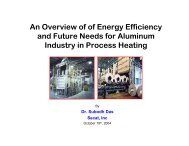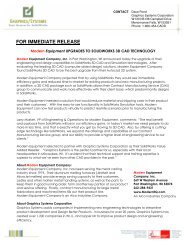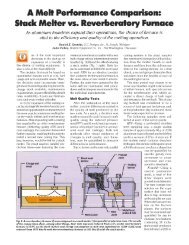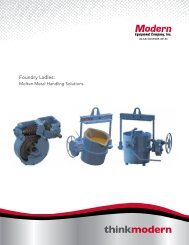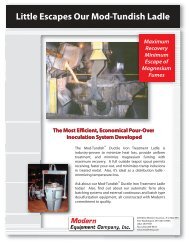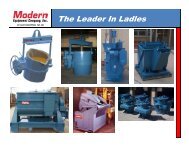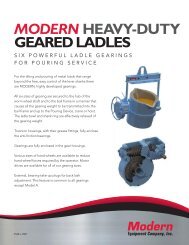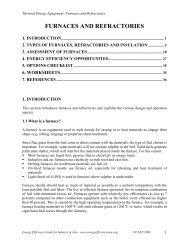ITP Metal Casting: Advanced Melting Technologies: Energy Saving ...
ITP Metal Casting: Advanced Melting Technologies: Energy Saving ...
ITP Metal Casting: Advanced Melting Technologies: Energy Saving ...
Create successful ePaper yourself
Turn your PDF publications into a flip-book with our unique Google optimized e-Paper software.
Executive Summary<br />
The metal casting industry is one of the most energy-intensive manufacturing sectors with the<br />
melting process accounting for over half (55%) of its energy consumption. Although its high<br />
energy expenses have been a significant concern for metal casters, the industry continues to use<br />
melting technologies with poor energy efficiency. The purpose of this study is to explore “Grand<br />
Challenge” or breakthrough opportunities that might dramatically reduce melting energy and to<br />
identify potentially energy-saving R&D areas based on the findings. The study was conducted to<br />
guide the <strong>Metal</strong> <strong>Casting</strong> subprogram of the Industrial <strong>Technologies</strong> Program (an initiative of the<br />
U.S. Department of <strong>Energy</strong>, Office of <strong>Energy</strong> Efficiency and Renewable <strong>Energy</strong>) in pursuing its<br />
energy reduction goal. The scope of the study includes current and emerging melting<br />
technologies in the industry worldwide, along with experimental technologies, retrofits for<br />
existing systems, and best practices.<br />
The seemingly simple melting operation – heating metals to turn them into liquids for pouring –<br />
is actually complex, involving a series of steps that incur material and energy losses. These<br />
losses are attributable to several factors: undesired conduction, radiation and convection, stack<br />
loss (flue gases), and metal loss. The extent of the losses depends on the furnace design, the fuel<br />
used, and the method of imparting heat to the metals. Exhibit 1 compares the efficiency and<br />
metal loss for different types of furnaces. The low thermal efficiency of current furnaces calls for<br />
high-priority R&D to improve melting technologies.<br />
<strong>Melting</strong> Furnace<br />
Typical<br />
Capacities*<br />
Crucible (Gas) 15 lbs - 1.5 tons<br />
Common Use Melt Loss<br />
Thermal<br />
Efficiency<br />
Aluminum 4-6% 7-19%<br />
Magnesium 4-6% 7-19%<br />
Copper-base 2-3% 7-15%<br />
Cupola 100 lb/hr - 20 tons/hr Iron 3-12% 40-50%<br />
Direct Arc †<br />
1.5 tons -100 tons Steel 5-8% 35-45%<br />
Immersion (low temperature<br />
melting)<br />
1,600lb/hr Zinc N/A 63-67%<br />
Induction †<br />
Reverberatory<br />
Electric †<br />
2 lbs - 50 tons<br />
0.5 tons - 125 tons<br />
Gas 0.5 tons - 125 tons<br />
Aluminum 0.75-1.25% 59-76%<br />
Copper-base 2-3% 50-70%<br />
Magnesium 2-3% 59-76%<br />
Iron 1-2% 50-70%<br />
Steel 2-3% 50-70%<br />
Aluminum 1-2% 59-76%<br />
Zinc 2-3% 59-76%<br />
Aluminum 3-5% 30-45%<br />
Zinc 4-7% 32-40%<br />
Rotary N/A Aluminum N/A 35%<br />
Stack Melter (Gas) 1 ton/hr - 10 tons/hr Aluminum 1-2% 40-45%<br />
*Information received from communication with AFS<br />
Source: DOE/CMC http://cmc.aticorp.org/datafactors.html<br />
† The primary energy efficiencies of these furnaces are much lower (about one-third) than the listed efficiencies due to the use of<br />
electricity, which involves sizeable energy losses during generation and transmission.<br />
Exhibit 1: Efficiency and metal loss for different furnaces<br />
i



